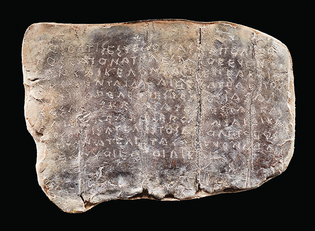
Christie’s
This ancient Greek curse, written on a thin lead sheet, was intended to stop one party from testifying against another in a judicial dispute—by either binding or incapacitating the rival. The curse is now in the Beinecke. No record as to how, or whether, the dispute was resolved.
View full image
This lead tablet is inscribed with a type of curse that was popular in the Ancient World, the defixio—designed to “bind,” restrain, or incapacitate an enemy, rival, or wrongdoer. Gamblers used them to prevent rivals’ horses from winning; lovers prevented fellow suitors from gaining their intended’s affections, and businessmen used them to restrain competitors. The particular defixio shown here is judicial in nature. The signatories intended to keep another party from testifying effectively against them in a court case.
The curse, which dates to the fifth century BCE, is inscribed on a lead sheet pounded thin. Lead was a medium for curses because it was both inexpensive and soft enough to be easily inscribed with a simple stylus. After the spell was written on the tablet, final steps were taken to “activate” the curse. The lead sheet would be folded over or rolled up, pierced with a nail, and deposited in a subterranean locale. One can see the vertical lines left after this tablet was rolled and flattened. (The fabric peeking out from the edges has been added by a modern conservator to stabilize the lead and keep it from further deterioration.)
Burying the tablet in a tomb or throwing it into a well effectively deposited it where the spirits of those who had met untimely deaths could either perform the actions expressed in the curse or convey the wishes to the Underworld realm. Excavations of tombs, wells, and baths have recovered many such curses. The site of the Roman Baths in Bath, England, for example, has yielded dozens of curses written in Latin.
Like much ancient writing, this Greek inscription has no spacing, capitalization, or punctuation. In this style, called scriptura continua (continuous writing), the letters are all the same size and they run together with no interruption. Children in this period were taught with word separation, but, like training wheels, blank spaces were removed when the pupil reached fluency. The lack of spacing indicates an adult and literate author.
According to Yale classics professor Jessica Lamont, the script and dialect suggest that this curse tablet was made in Sicily. We know little about the people who composed these curses. Magic had an uneasy place within the ancient city, and it is thought that these rituals were taboo and practiced with some secrecy—this, despite their wide popularity across the Mediterranean world (and well beyond). Although much Classical literature associated the performance of magic with women, the status of the people involved in this curse and their names, not to mention the context of litigation, suggest they were men.
 loading
loading
2 comments
-

Steve Schewe, 12:07pm March 10 2021 |  Flag as inappropriate
Flag as inappropriate
-

Wendy E Valleau, 3:01pm March 14 2021 |  Flag as inappropriate
Flag as inappropriate
The comment period has expired.For the curses hurled into wells, were they literally poisoning their water supply with hate? A metaphor for our times.
Is there a transliteration and a translation of this tablet available anywhere?